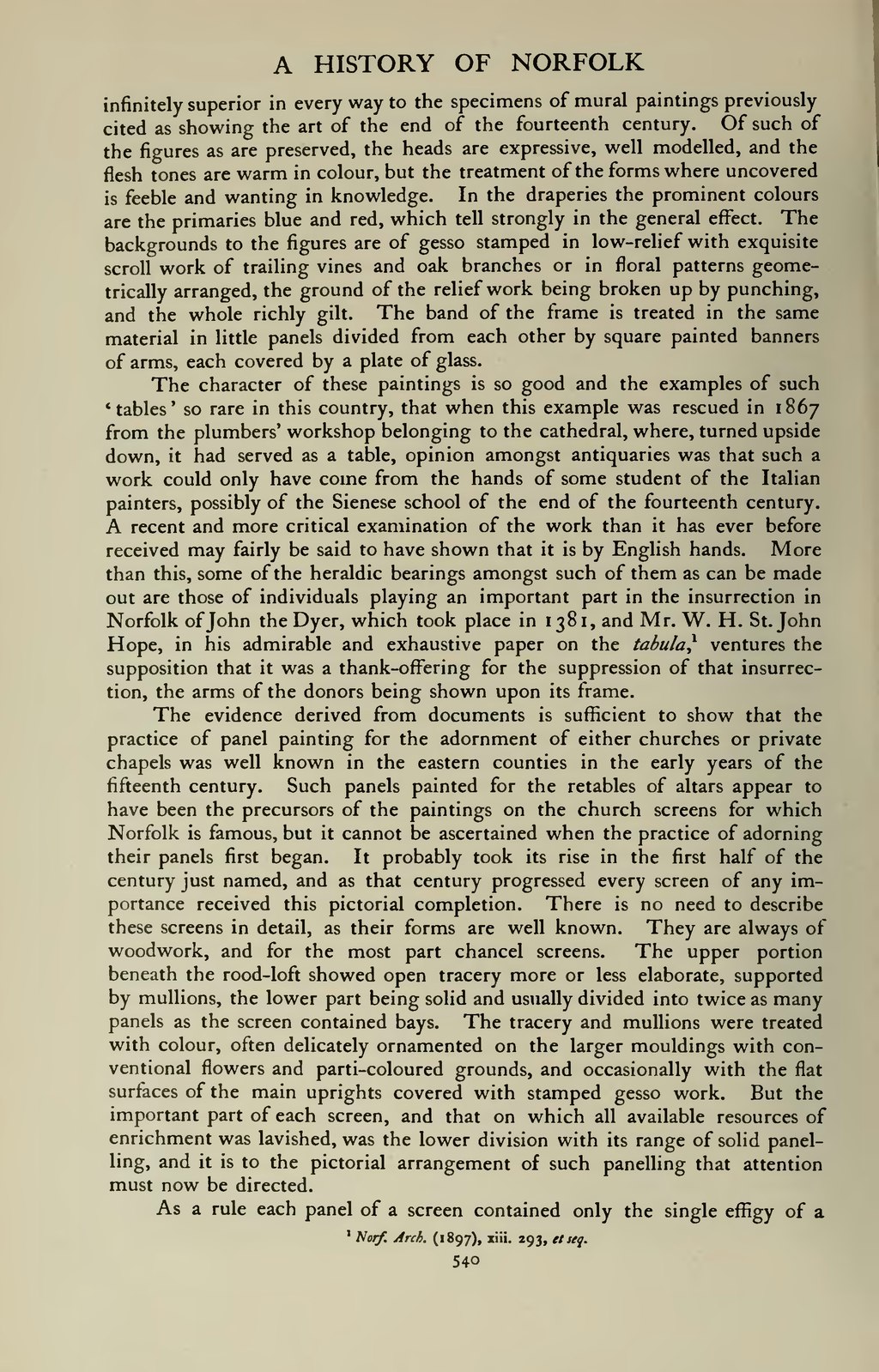A HISTORY OF NORFOLK infinitely superior in every way to the specimens of mural paintings previously cited as showing the art of the end of the fourteenth century. Of such of the figures as are preserved, the heads are expressive, well modelled, and the flesh tones are warm in colour, but the treatment of the forms where uncovered is feeble and wanting in knowledge. In the draperies the prominent colours arc the primaries blue and red, which tell strongly in the general effect. The backgrounds to the figures are of gesso stamped in low-relief with exquisite scroll work of trailing vines and oak branches or in floral patterns geome- trically arranged, the ground of the relief work being broken up by punching, and the whole richly gilt. The band of the frame is treated in the same material in little panels divided from each other by square painted banners of arms, each covered by a plate of glass. The character of these paintings is so good and the examples of such 'tables' so rare in this country, that when this example was rescued in 1867 from the plumbers' workshop belonging to the cathedral, where, turned upside down, it had served as a table, opinion amongst antiquaries was that such a work could only have come from the hands of some student of the Italian painters, possibly of the Sienese school of the end of the fourteenth century. A recent and more critical examination of the work than it has ever before received may fairly be said to have shown that it is by English hands. More than this, some of the heraldic bearings amongst such of them as can be made out are those of individuals playing an important part in the insurrection in Norfolk of John the Dyer, which took place in 1381, and Mr. W. H. St. John Hope, in his admirable and exhaustive paper on the tabula, ventures the supposition that it was a thank-offering for the suppression of that insurrec- tion, the arms of the donors being shown upon its frame. The evidence derived from documents is sufficient to show that the practice of panel painting for the adornment of either churches or private chapels was well known in the eastern counties in the early years of the fifteenth century. Such panels painted for the retables of altars appear to have been the precursors of the paintings on the church screens for which Norfolk is famous, but it cannot be ascertained when the practice of adorning their panels first began. It probably took its rise in the first half of the century just named, and as that century progressed every screen of any im- portance received this pictorial completion. There is no need to describe these screens in detail, as their forms are well known. They are always of woodwork, and for the most part chancel screens. The upper portion beneath the rood-loft showed open tracery more or less elaborate, supported by muUions, the lower part being solid and usually divided into twice as many panels as the screen contained bays. The tracery and muUions were treated with colour, often delicately ornamented on the larger mouldings with con- ventional flowers and parti-coloured grounds, and occasionally with the flat surfaces of the main uprights covered with stamped gesso work. But the important part of each screen, and that on vv^hich all available resources of enrichment was lavished, was the lower division with its range of solid panel- ling, and it is to the pictorial arrangement of such panelling that attention must now be directed. As a rule each panel of a screen contained only the single efHgy of a ' Norf. Arch. (1897), xiii. 293, et sej. 540
Page:VCH Norfolk 2.djvu/586
This page needs to be proofread.
